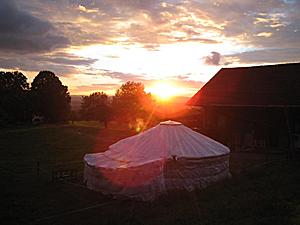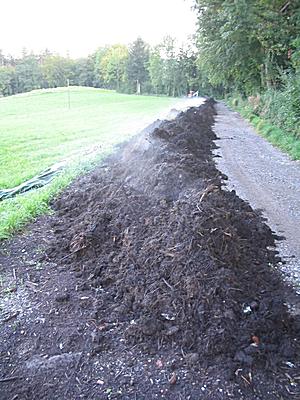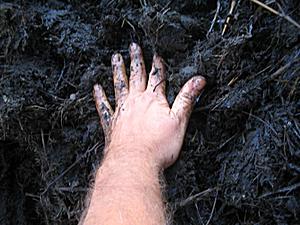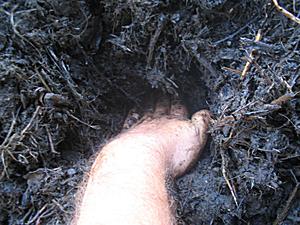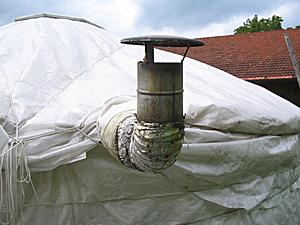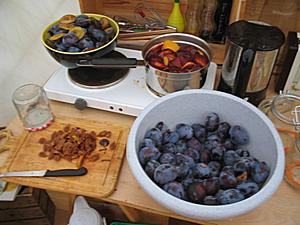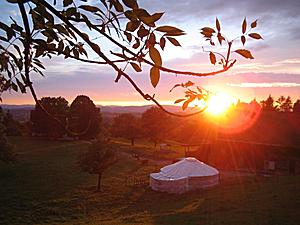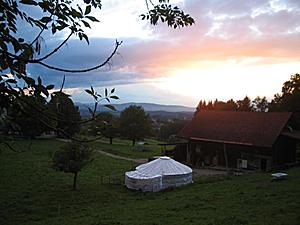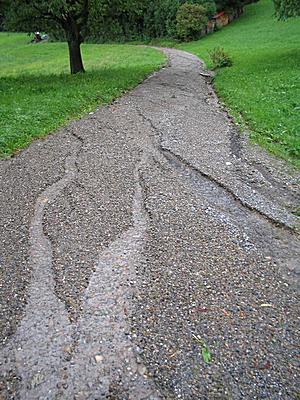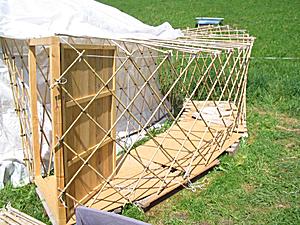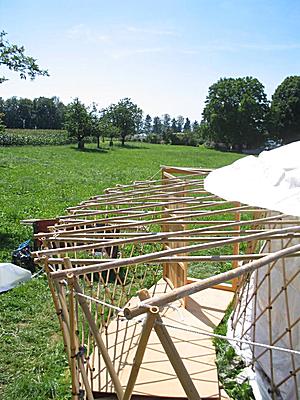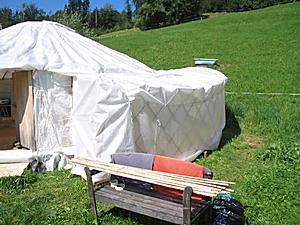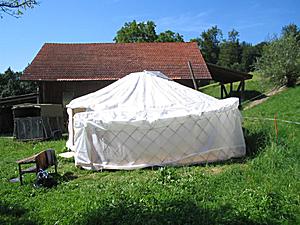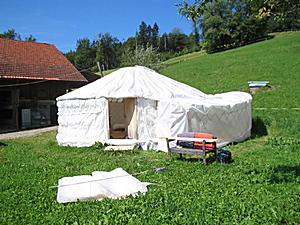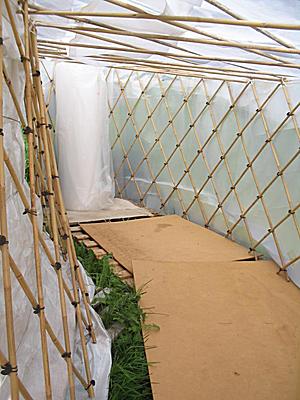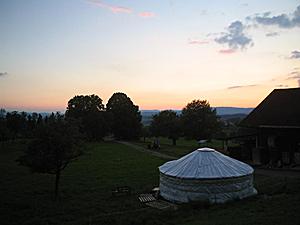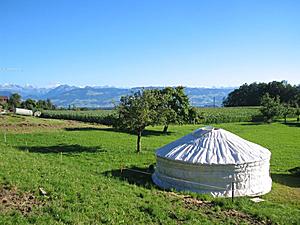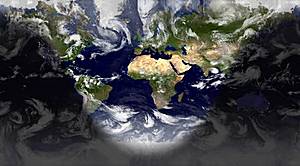
|
Page << Prev | 1 | 2 | 3 | 4 | 5 | 6 | 7 | 8 | 9 | 10 | 11 | 12 | 13 | 14 | 15 | 16 | 17 | 18 | 19 | 20 | 21 | Next >> Yurt / Ger Diarywritten by Rene K. Mueller, Copyright (c) 2005, 2006, 2007, 2008, 2009, last updated Sat, January 3, 2015 5. 9. 2007: Temperature Range
I fire the stove only at night, from 20:00 for 1-2 hours only - in the morning I put on some more cloth at 8°C til the sun reaches the yurt and heats up the interior by 20°C then. It would make sense to put up the thermal insulation to keep more warmth through the night. Compost as Heat Source I also had a talk with the farmer a few days ago about the compost he takes from a waste deposit facility, and he piles the compost in lanes for a couple of weeks, those create heat of 70-80°C. After two weeks or so the compost drops its temperature. So I tried it myself, approached the mildly odor giving pile of compost, and on the surface the temperature is a bit below my body temperature, the compost is surprising very wet or moist and slippery. Then I reached into the pile and at 10cm depth it goes well above 40°C, maybe 50°C as I can't keep my hand there without burning the tips of my fingers. It's incredible to realize it's so hot that you can burn yourself, and this kind of heat without a fire or electricity, but an organic decomposting process.
3. 9. 2007: Attached Stove Pipe Again
Also the negotiated one year to stay at the current place is approaching its end, and this means either renegotiate or find another place, let's see.
30. 8. 2007: Harvesting Bluebyrd Plums
So, I harvested apprx. 8kg plums myself, way too much to make jam from, but I also can't store them without processing them as they ripe further and then rod then. I will prepare them by remove the core/seed/stone/pit and cook and make unsweetened sauce and fill up in glasses. Finally I made half as jam and half as sauce without additional sweetener and thickener, some I blended even to make it smoother. I used a lot of water (8l) to sterilize all glases and keep everything clean - but it's worth the effort. These are the little things which come along living in a temporary habitat, and close to nature - you are harvesting what nature provides, such as cherries, plums, and soon apples, and when it's season they come in abundance, in large quantities and require preparation to store them, e.g. for a year. Watching Neolithics of Pfyn in a row, and considering more food from the nature close by leads to build a garden, and this of course involves a longer commitment to stay at a place, which I'm pondering on now. The last days I also noticed the first dry leafs falling from the trees, and fog in the morning - fall is approaching. 29. 8. 2007: Neolithics of Pfyn
The slow pace of the life, and closeness to nature became appearant and was well captured in the coverage. The print media mocked the experiment as boring, slow and without any uniqueness - but I can't subscribe this, I rather find it odd that people cannot appreciate the different pace of living in such a setting, maybe even unable to relate and understand themselves. Anyway, it was also from the ratings very successful, 50% market share here in Switzerland which is exceptional well, especially given it wasn't made with any silly sensationalism which otherwise seems predominant in TV productions. I personally don't watch TV anymore, not even live-streamed.
I took the time to write a little feature on this TV project, you can reach it at SimplyDifferently.org: Neolithics of Pfyn 23. 8. 2007: Radio Feature
Update: 2007/10/10: it took them forever to send me a copy, so finally:
If I get some spare time I may transcribe it. The feature turned out surprisingly nice, and kind of hilareous to listen myself and the jokes I made, silly.
I also just realized that SF1: Pfahlbauer von Pfyn 19. 8. 2007: Mild Days & Attached Room
The attached room does well, no strong wind or storm yet tested it, but heavy rain I had and the room was steady and the overall setup leakfree.
I also captured a few mice again, with the alive-trap I had - and dislocated them in the nearby forest.
9. 8. 2007: 2-3 Days Rain: Some Floods & Drinking WaterApprx. 24-36 hours intense rain over a period of 2-3 days created some floods here in Switzerland (e.g. up to 100l per day per m2, which is apprx. 75% of total rainfall for month August in average), various rivers run high and a few areas are evacuated, or are not reachable anymore on the ground, and have no electricity anymore, not really dramatic but significant to see it takes just a few days of rain to create this kind of effect. Southern Germany and northern Italy are alike affected.
My newly attached room did fine, at one part I had a dent where water collected (maybe 15l), which I use now as drinking water - as due the heavy rain the water I get from the well contains surface water too, not sufficient filtered through the ground - so I prefere the rain water. The rain water itself should be very sterile as it has been evaporated and now are clouds (removed all remaining particles), the only contamination is due the air pollution, but given I collected rain water of 2nd day (flushed the early collected water from the first day of rain) should minimalize the pollution based contamination. With the rain it also cooled off, from 28°C temperatures down to 12°C now, and covered sky - inside the yurt now 16°C around noon. 4. 8. 2007: Attached RoomIn order to create some additional space I thought to use the lattice wall of my 4m yurt and its door in order to create an attach room:
The last weeks have been mild, a few days with lot of rain again, but it cleared up again.
13. 7. 2007: Summer Back & Bamboo Treatment
For the first time since I brightened the roof and wall bamboo, I had one wall bamboo crack again due the heat. Until now no additional roof bamboo has cracked which I painted more carefully than the lattice wall, harder to paint due all the spaces within the lattice grid (rather brighten the lattice lath before binding them to a wall). I may prematurely conclude already, the brightening of the bamboo minimizes the risk of the bamboo to crack, contrary to what I first was told by the whole sale garden company. The older the bamboo, the greater the risk of splitting as the bamboo get drier and thereby stiffer and less flexible to react to temperature changes like expansion and compaction, the oposite as I was told that remaining humidity within the bamboo was the reason for cracks - I don't think so now anymore.
I also test a piece of fleece, made of PE fabric I guess, quite robust, aprx. 2-3mm thick, it's used by the farmer for covering compost he processes (formerly "green" waste), I thought to see if I could use it as thermal insulation or wall cover. It soaks itself with water quickly, but drains it quickly too, and dries even so fast. It doesn't rot at all and catches little moss.
10. 7. 2007: Cooler Weather & Rain Again
The door frame bottom I covered additionally with a piece of PE also does much better, much lesser water entry at the door as before. Having an extending cover for the door entry for rainy regions is highly recommended, and I may even extend mine further for the fall - this way to protect the wodden door frame further (I used water protecting finish, yet it didn't last much longer than 4-5 months). The rain also made the ground around the yurt soaked, and I'm glad the place I put up the yurt had gravel already for quite some time which made it more solid, additionally to the gravel I put on - otherwise I would think the floor remaining as stable as it is now. The last weeks, before it began to rain, I harvested cherries from the farmer's trees, and made jam, the same with peaches I bought, they ripe faster in the warm yurt and I didn't want them put in the plastic box in the water well, where I otherwise store food which needs to be cool. In general I cook vegetables entirely, one part to eat as meal direct, another parts I blend and mix with olive oil as salty paste and put (still hot) it into empty jam jars, to use later as cooking additives or on bread. Maybe it's getting time to collect my cooking recipes too. The last 3-4 days I catched 4 mice with a living mouse trap, it seems the rain of the last days and week made them seek drier place, my yurt - yet, their urine and feces make co-living the same space inacceptable, sorry mice! So I dislocated each of them in the nearby forest. Page << Prev | 1 | 2 | 3 | 4 | 5 | 6 | 7 | 8 | 9 | 10 | 11 | 12 | 13 | 14 | 15 | 16 | 17 | 18 | 19 | 20 | 21 | Next >> Content:
|
| Home | · | About | · |  Tipi | · |  Yurt | · |  Dome | · | Features | · | Gallery |

Creative Commons (CC) BY-SA-NC 2005-2017, developed, designed and written by René K. Müller
Graphics & illustrations made with Inkscape, Tgif, Gimp, PovRay, GD.pm
Web-Site powered by FreeBSD & Debian/Linux - 100% Open Source

